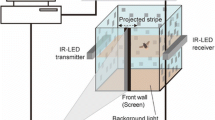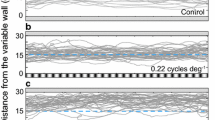Abstract
The paths of Colorado beetles (Leptinotarsa decemlineata Say)in a featureless environment are circular. This behavior is explained by an internal asymmetry. To stabilize the path, the fixation reaction or the optomotor response must work against this asymmetry. The turning behavior was examined in stationary patterns of vertical stripes different at spatial wavelengths (λ). The internal asymmetry was tested in a horizontally striped pattern. A stable fixation reaction was found only for Λ ≥ 120 °. The results suggest that larger intrinsic turning tendencies shifts the stable point of the fixation reaction. The same vertically striped patterns were rotated to examine the following reaction of the beetle. It is concluded that the fixation component of the response of these insects, in particular, does not differ in the two situations.
Similar content being viewed by others
References
Batschelet, E. (1981).Circular Statistics in Biology, Academic Press, New York.
Böhm, H. (1987).Die Anemotaxis beim Totengräber Necrophorus humatorF. (Silphidae, Coleoptera), Thesis, Köln.
Buddenbrock, W., and Moller-Racke, I. (1954). Untersuchungen über die Optomotorik und die retinalen Bildverschiebungen bei den KornkäfernCalandra aryzae undC. granaria.Zool. Jahrbuch Abteilung allgemeine Zool. Physiol. 65: 219–236.
Bülthoff, H., and Wehrhahn, C. (1984). Computation of motion and position in the visual system of the fly (Musca). Experiments with uniform stimulation. In Varjd, D., and Schnitzler, H. U. (eds.),Localization and Orientation in Biology and Engineering, Springer, Berlin, pp. 149–152.
Collett, T. S. (1980). Angular tracking and the optomotor response. An analysis of visual reflex interaction in a hoverfly.J. Comp. Physiol. 140: 145–158.
Geiger, G., and Nässel, D. R. (1982). Visual processing of moving single objects and wide-field patterns in flies: behavioural analysis after laser-surgical removal of interneurones.Biol. Cybern. 44: 141–149.
Götz, G. (1975). The optomotor equilibrium of theDrosophila navigation system.J. Comp. Physiol. 99: 187–210.
Heisenberg, M., and Wolf, R. (1984).Vision in Drosophila, Springer, Berlin, Heidelberg, New York.
Kramer, E. (1975). Orientation of the male silkmoth to the sex attractant bombykol. In Denton, D. A., and Coghlan, J. P. (eds.),Olfaction and Taste, Academic Press, New York, pp. 329–335.
Lönnendonker, U. (1984).Der Beitrag von Fixation und Optomotorik an der Orientierung laufender Kartoffelkäfer—Statische und dynamische Aspekte beider Systeme, Thesis, Köln.
Lönnendonker, U., and Scharstein, H. (1991). Fixation and optomotor response of walking Colorado beetles: Interaction with spontaneous turning tendencies.Physiol. Entomol. 16: 65–76.
Meyer, H. W. (1978). Phototaxis in the walking male and female fly (Calliphora erythrocephala Meig.). II Water balance and phototactic response.Biol. Cybern. 31: 7–13.
Osorio, D., Srinivasan, M. V., and Pinter, R. B. (1990). What causes edge fixation in walking flies?J. Exp. Biol. 149: 281–292.
Pick, B. (1976). Visual pattern discrimination as an element of the fly's orientation behavior.Biol. Cybern. 23: 171–180.
Preiss, R., and Kramer, E. (1984). The interaction of edge fixation and negative phototaxis in the orientation of walking gypsy moths,Lymantria dispar.J. Comp. Physiol. A 154: 493–498.
Radl, E. (1906). Einige Bemerkungen über den Phototropismus der Tiere.Biol. Centralblatt 26: 677–690.
Reichardt, W. (1969). Movement perception in insects. In Reichardt, W. (ed.),Proceedings of the International School of Physics “Enrico Fermi”, Processing of Optical Data by Organisms and by Machines, pp. 465–493.
Reichardt, W., and Poggio, T. (1976). Visual control of orientation behavior in the fly. I. A quantitative analysis.Q. Rev. Biophys. 9: 311–375.
Sachs, L. (1978).Angewandte Statistik, Springer, Berlin, Heidelberg, New York.
Schmitz, B., Scharstein, H., and Wendler, G. (1982). Phonotaxis inGryllus campestris L (Orthoptera, Gryllidae) I. Mechanism of acoustic orientation in intact female crickets.J. Comp. Physiol. 148: 431–444.
Schöne, H. (1980).Orientierung im Raum, Wissenschaftliche Verlagsgesellschaft, Stuttgart.
Varjú, D. (1973). Übertragungseigenschaften im Auswertesystem für das Bewegungssehen. In Lueken, B., and Scharf, J. H. (eds.),Nova Acta Leopoldina. 208: 173–193.
Varjú, D. (1975). Stationary and dynamic responses during visual edge fixation and negative phototaxis in the mealworm beetleTenebrio molitor.Nature 255: 330–332.
Varjú, D. (1976). Visual edge fixation and negative phototaxis in the mealworm beetleTenebrio molitor.Biol. Cybern. 25: 17–26.
Varjú, D. (1987). The interaction between visual edge fixation and skototaxis in the mealworm beetleTenebrio molitor.J. Comp. Physiol. A 160: 543–552.
Virsik, R. P., and Reichardt, W. (1976). Detection and tracking of moving objects by the flyMusca domestica.Biol. Cybern. 23: 83–98.
Voss, C. (1967). Über das Formensehen der roten Waldameise (Formica rufa Gruppe).Z. Vergl. Physiol. 55: 225–254.
Weber, T., Thorson, J., and Huber, F. (1981). Auditory behaviour of the cricket. I. Dynamics of compensated walking and discrimination paradigms on the Kramer treadmill.J. Comp. Physiol. 141:215–232.
Wehner, R. (1981). Spatial vision in arthropods. In Autrum, H. (ed.),Handbook of Sensory Physiology, Vol. VII/6C, Springer, Heidelberg, pp. 287–616.
Wehrhahn, C., Hausen, K., and Zanker, J. (1981). Is the landing response of the housefly (Musca) driven by motion of a flow field?Biol. Cybern. 41: 91–99.
Wendler, G., and Scharstein, H. (1986). The orientation of grain weevils (Sitophilus granarius): Influence of spontaneous turning tendencies and of gravitational stimuli.J. Comp. Physiol. A. 159: 377–389.
Wilson, D. M., and Hoy, R. R. (1968). Optomotor reaction, locomotory bias and reaction inhibition in the milkweed bugOncopeltus and the beetleZophobas.Z. Vergl. Physiol. 58: 136–152.
Zanker, J. M., and Collett, T. S. (1985). The optomotor system on the ground: On the absence of visual control of speed in walking ladybirds.J. Comp. Physiol. A 156: 395–402.
Author information
Authors and Affiliations
Rights and permissions
About this article
Cite this article
Lönnendonker, U. Optomotor reaction and fixation of walking colorado beetles (Coleoptera: Chrysomelidae): Course control aspects. J Insect Behav 4, 347–365 (1991). https://doi.org/10.1007/BF01048283
Accepted:
Issue Date:
DOI: https://doi.org/10.1007/BF01048283




